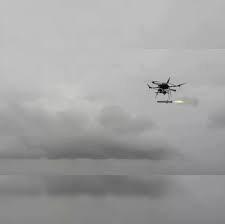DRDO test-fires drone-launched missile in Andhra

The Defence Research and Development Organisation (DRDO) successfully test-fired the UAV-Launched Precision Guided Missile (ULPGM)-V3 at the National Open Area Range in Kurnool, Andhra Pradesh. This milestone marks a major leap in India’s efforts to advance indigenous defence technology, especially in unmanned aerial vehicle (UAV) weapon systems.
Advancing Indigenous Defence Innovation
The ULPGM-V3 is a next-generation air-to-ground missile designed specifically for drones. This test shows India’s growing expertise in missile technology that pairs drones with precision strikes. The system supports India’s ‘Atmanirbhar Bharat’ vision to build self-reliant defence capabilities.
Unlike traditional missiles that need manned aircraft, the ULPGM-V3 launches from drones, offering stealth and precision. This technology lets the Indian armed forces strike high-value targets while minimizing risks to personnel. The missile uses a passive homing system with an imaging infrared (IR) seeker. It “fires and forgets,” making it highly effective in fast-paced combat.
Key Features of ULPGM-V3
The missile’s imaging IR seeker locks onto heat signatures, enabling accurate targeting day and night. Since it operates passively, the missile avoids emitting signals that enemy forces could detect. This stealth feature improves the chance of a successful strike with minimal collateral damage.
Its design also allows quick reactions to dynamic battlefield conditions. The missile’s ability to launch from drones increases the military’s reach in challenging terrains where manned aircraft face limitations.
Strengthening India’s Strategic Defence
The ULPGM-V3 test significantly boosts India’s combat readiness. Drones are becoming essential for modern warfare, used increasingly for offensive roles. Pairing missiles like ULPGM-V3 with UAVs enhances India’s tactical options. It enables targeted strikes without risking pilots or aircraft.
This breakthrough reduces India’s dependence on imported weapons. With neighbours upgrading their militaries, this missile strengthens India’s deterrence and security posture.
Collaborative Success with Industry Partners
Defence Minister Rajnath Singh congratulated DRDO and its partners on this achievement. He praised Defence Public Sector Undertakings (DPSUs), Micro, Small, and Medium Enterprises (MSMEs), and startups for their contributions. This collaboration highlights the growing role of private industry alongside government research in defence innovation.
Such teamwork accelerates weapon development and nurtures new technologies. MSMEs and startups bring flexibility and expertise, complementing the scale and resources of DRDO. Together, they drive India’s ‘Make in India’ and self-reliance goals in defence.
Broader Impact on Defence Technology
The ULPGM-V3’s success opens the door for more advanced drone-launched weapons. India plans to integrate such missiles with various UAVs used across its Army, Navy, and Air Force.
Indigenous missile production also gives India more control over its defence needs. It limits reliance on foreign suppliers and could eventually create export opportunities, boosting the defence manufacturing sector.
Looking Ahead: Enhancing Combat Capabilities
DRDO will likely conduct further tests to improve the missile’s range, seeker performance, and networked warfare features. These improvements will help multiple UAVs coordinate strikes in complex scenarios.
Developing drone-launched precision missiles aligns with global military trends favoring unmanned systems. India’s investments ensure its forces stay ahead of evolving threats and maintain tactical superiority.
Conclusion
DRDO’s successful test of the UAV-Launched Precision Guided Missile-V3 from Kurnool highlights India’s progress toward defence self-reliance. The missile enhances India’s strike capabilities and emphasizes the rising role of drones in warfare.
By fostering partnerships among DRDO, DPSUs, MSMEs, and startups, India builds a strong defence innovation ecosystem. This ecosystem will help the country meet future security challenges and emerge as a leader in next-gen defence technologies.






